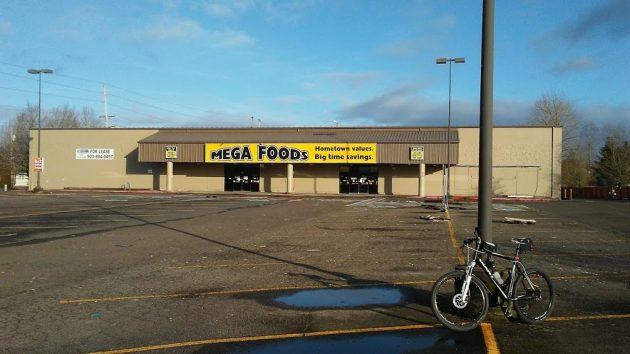
The vacant former supermarket at 2000 Queen Ave. S.E. on Jan. 23.
Albany’s zoning code makes it difficult to find a use for the former Mega Foods supermarket, so the owners are seeking a zone change that would allow a full range of commercial possibilities.
Some time after the 42,000-square-foot supermarket was built in 1990, the city changed the zoning to a category, “neighborhood commercial,” that allowed no stores bigger than 5,000 square feet. This didn’t affect the market, which operated until the owners closed it in 2017 because of stiff new competition. But last year a real estate agent told me the zoning made it impossible to sell or lease the place.
The Albany Planning Division says the owners, who give an address in Santa Monica, have filed for a change in the comprehensive plan and the zoning map, from “neighborhood commercial” to “community commercial.” The city posted a public notice of the request on March 25. The planning commission will hold a public hearing on April 15, and a hearing before the city council is set for May 8.
Assuming the change gets the green light, what will happen with the property? The owners haven’t said, and they may not yet have any definite plans.
David Martineau, the city’s planning manager, says the proposed zoning would allow businesses of the kind that now line Pacific Boulevard, Ninth Avenue, and S.E. Santiam Highway. “Uses could include, but are not limited to, retail stores, offices, restaurants, auto dealerships, self-serve storage, service stations, vehicle repair, and small-scale manufacturing.”
Land across Geary Street from the Mega Foods site is already zoned community commercial. That’s where The Wheeler-Dealer and the Ramen restaurant are in business.
The schedule of permitted uses in the “community commercial” zone starts with “adult entertainment” and includes all the ones Martineau mentioned. All of them would require city approval of a site plan, at least. So, when and if the owners find a use, the public will know what it is when they file their plan. (hh)
Planning Manager David Martineau provided this clarification Friday: “While ‘Adult Entertainment’ is allowed in the Community Commercial zone through an approved Site Plan Review, this use would not be allowed on the Mega Foods property because adult entertainment cannot be located or expanded within 300 feet of the district boundary line of any residential zoning district. The site is surrounded by residential zoning. The Development Code provides a variance procedure as an exception to this distance standard, but the burden would be on the applicant to show what unusual hardship exists.”


At the risk of irritating you with irresponsible commentary about the folly of zoning laws, I offer the following about the problem with coercive, centrally planned, land use.
Coercive zoning laws involve arbitrary bureaucratic discretion over private property rights. On the other hand, a system of voluntary zoning between covenant holders is a better approach to determining how private property will be used. This approach ensures that rational economic calculation rooted in private interest occurs free of political advocacy and decision making.
In the context of a free society, which do you prefer? Private land use governed by a coercive government, or private property where allowable uses are governed on a contractual basis between voluntary people?
I suppose it boils down to who do you fear most – the folks in your neighborhood or your local government?
Honest question: what is “a system of voluntary zoning”? Is that actually a thing, or is it another way of saying, “no zoning”?
While I think many zoning laws are unnecessary and oddly specific, I would disagree with you that they are “arbitrary.” I live in a quiet, residential neighborhood. It’s a nice place to raise a family. Should my next-door neighbor be allowed to tear his house down and build a 24-hour convenience store? Or a biker-bar, or a 20-floor office building? Extreme examples, obviously, but how would that be, “governed on a contractual basis between voluntary people?”
What a refreshing comment! Defending private property rights is as heroic and necessary as defending our country.
GS
Seems that your dalliance with the other side is over.
Just to be clear, the property owners in this situation live in Santa Monica and are in no way part of the community. Whereas the “evil government” is making their decision using a community forum. So it sounds like you may have it backwards.
This argument collapses in this phrase: “Private land use governed by a coercive government, or private property where allowable uses are governed on a contractual basis between voluntary people?”
The very use of the term “allowable uses” implies that some unit of enforcement somewhere would be making the “allowable” determinations. Is this not what the current zoning regulatory regimen already does? If so, then the proposed argument would simply replace one regulatory regime with another. Why bother? Just more bureaucratic expense to achieve the same result.
I say Albany needs a place for kids to learn ice hockey! I had always thought the old Safeway building would be great.
Ice Hockey sounds like fun. If you follow the model of some other facilities, there can be a floor that goes over the ice for other activities. Anything from laser tag or paintball to black light mini golf to court sports.
Homeless shelter?
Hasso,
I would never know what is happening all around me if it was not for you letting us know. I do not take the local paper any more because it was not worth the money.
THANK YOU